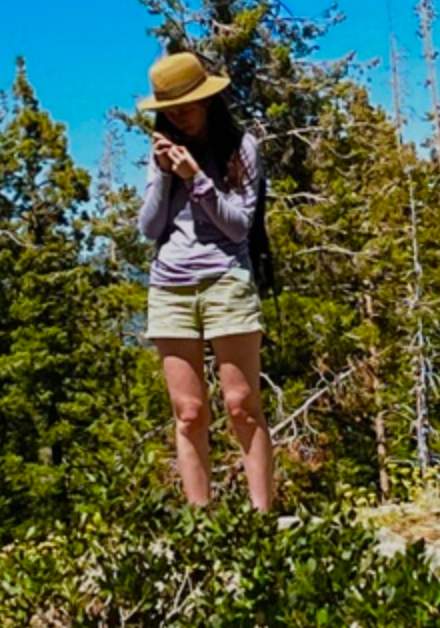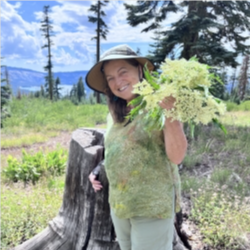Plant Uses of the Sierra: Medicine, Food & Utilitarian
Dates: Aug 14-17, 2025
Instructor: Kathi Keville
Fee: $370.00 + meals and accommodations fees
Term: Summer 2025
Workshop Description
This year we’re offering a second course by Kathi Keville that explores the Sierra Nevada's ethnobotany and rich plant diversity. This time, our field trips take us to impressive vistas and meadows in search of plant medicine and wild edibles. You will learn to identify and use these plants while we discuss their ethical harvest. Kathi will blend ethnobotany (plant use) and concepts by indigenous peoples worldwide with modern science, plus her own vast experience using wild plants for several decades. We will cover the local and worldwide historical significance for plant use in ceremony, basketry, tea, skincare products, and medicine. Learning the botany, plant knowledge, aroma, and even the plant lore will assure you can ID each plant in the future. (A handy way to assist plant ID is to bring tape so you can attach small plant samples in your notebook and create your own mini-herbarium along the way.)
Our wild food includes acorn selection and preparation and then creating an assortment of very tasty acorn dishes. Kathi and assistant herbalist Veroniqué Samson have been eating acorns for decades as a regular part of their diet and know several techniques for leaching and prep. Our acorn dishes will join other wild foods we collect for a very wild lunch. Late summer is berry and seed season. That means this will include elderberry, rosehip, juniper dishes, plus seed bread and pine needle tea—not only to eat but to learn their medicinal properties. We will also cover how high Sierra plants can be used effectively as natural medicines to treat many disorders, including pain, wounds, fever, flu, and digestive and urinary tract complaints. Kathi will show off her herbal 1st-aid kit to show how even more plants can be turned into simple remedies. Handouts include plants lists and notes on their uses.
Each day, we venture out to explore a different eco system. Then, we return to campus for a lab to make herbal concoctions. The easy hikes are short and move very slowly since there is an abundance of plants to see. This is the first year we’ve offered a second course, so assistant herbalist Veroniqué Samson and I are still deciding upon the best field trip locations from all the ones we’ve scouted so far. Wherever we go, we can look forward to fun plant education.


Instructor Bio
Kathi Keville is a renowned herbalist, founder of the American Herb Association and author of 16 herb books. She also contributed the ethnobotanical knowledge to Wildflowers of Nevada and Placer Counties, California. She lives in the Sierra surrounded by landscaped display gardens containing 500 medicinal plants from around the world. Her Green Medicine Herb School offers classes on foraging wild foods, medicinal plants, herb garden cultivation, and aromatherapy, including a multi-weekend Medicinal and Edible plant apprenticeship intensive. Kathi teaches throughout the US and in Europe and leads botanical trips to Italy. She has taught this very popular SF Field Campus course for over 30 years with her enthusiastic passion for nature. This year, she adds a second Useful Plant weekend with different fields trips and new projects. Both courses are taught with assistant herbalist Veroniqué Samson. Hear Kathi’s KVMR radio show (kvmr.org) or find pictures of her plant adventures on social media. You can learn more by visiting or contacting her through her website.
Workshop Details
Workshop Schedule
TBA
Workshop Supplies List
TBA
Lodging and Camping Supplies
Camping gear if you are staying on campus:
- tent and sleeping pad (unless you are staying in our tent with a cot provided)
- warm sleeping bag
- pillow, toiletries, and towel
- flashlight and lantern
- alarm clock
Field gear for everyone:
- day pack
- sunscreen
- insect repellant
- water bottles
- plastic containers for packed lunches
- sense of humor
You might also want to bring:
- camera
- binoculars
- hand lens
- camp chair
Clothing:
The weather in the Sierra Nevada can vary greatly, even in a single day. Be prepared for chilly temperatures at night, even below freezing early in the summer. Rain is a possibility any time, whether forecast or not. Variable weather clothing that can be layered is best: long pants and a long-sleeved shirt, warm sweater and jacket, t-shirt and shorts or skirt, sturdy shoes or hiking boots, sun hat, rain gear, and a warm hat or gloves for cold weather and/or night activities. And, if you come later in the season, bring your swimsuit for afternoon dips in the lakes!